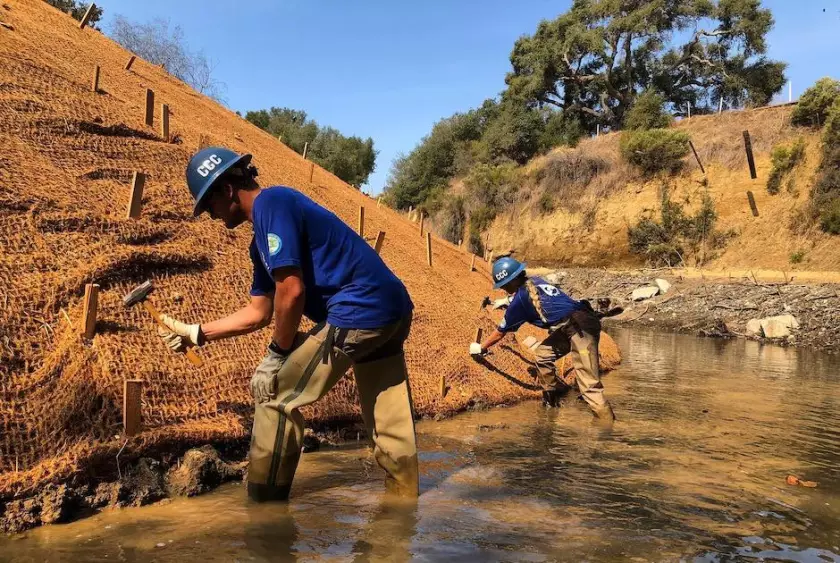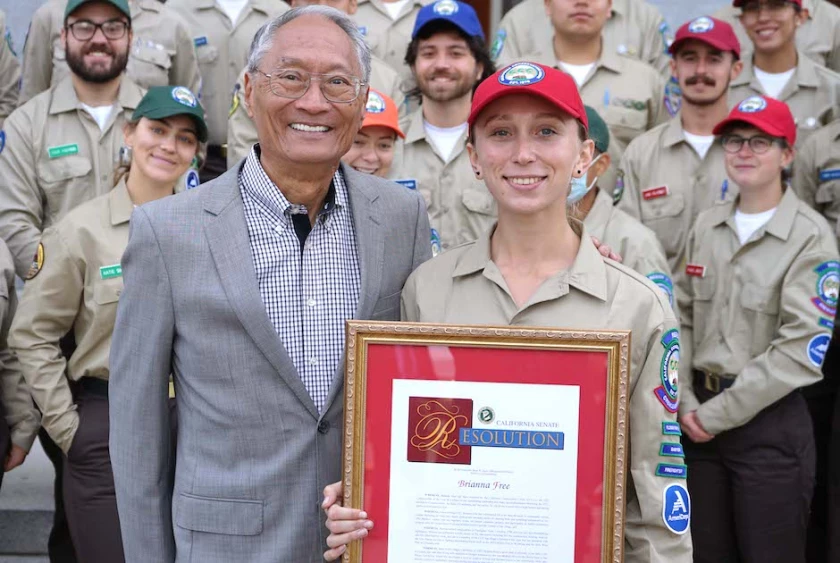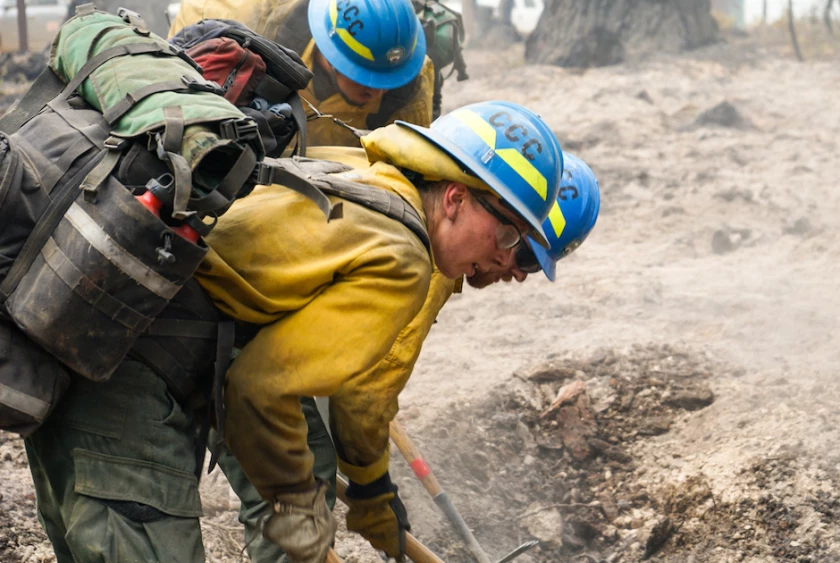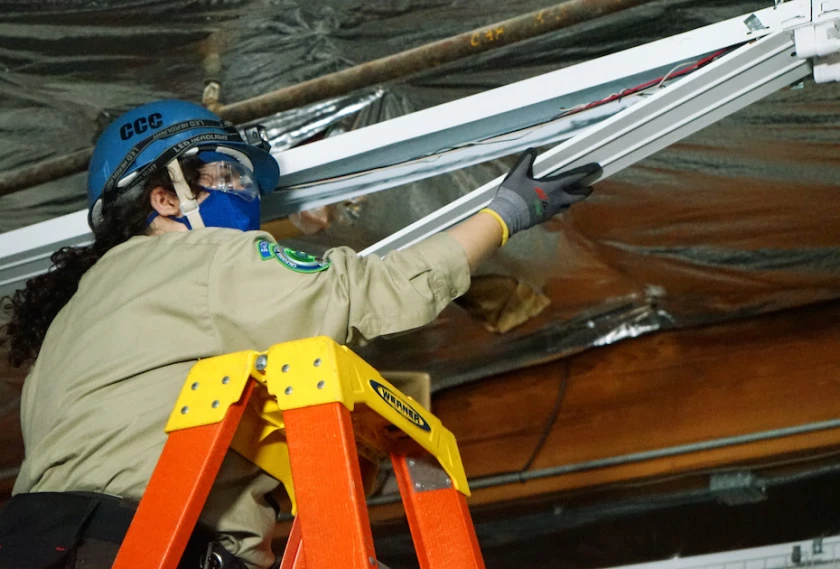For almost half a century, the California Conservation Corps (CCC) has helped young people cultivate the bedrock skills on which environmental stewardship depends. Founded in 1976 by Gov. Jerry Brown, the CCC is the oldest program of its type in the country and the model for scores of similar programs that are more important to the nation than they have ever been.
The CCC’s motto, “Hard Work, Low Pay, Miserable Conditions and More!,” echoes the sensibilities of its founder. Jerry Brown’s audacious vision, says CCC Director Bruce Saito, was to combine an Israeli kibbutz where people from different backgrounds could work together, a Jesuit seminary encouraging participants to think about their actions and reflect on their whole being and a Marine boot camp.
The corps was patterned after the Civilian Conservation Corps Franklin D. Roosevelt established during the Great Depression to protect forests, parks and public lands. Over nine years, corpsmembers planted over 3 billion trees and built shelters and trails in more than 800 parks throughout the nation. In addition to pay, room and board, they were given educational opportunities.
At the time the California corps was created in the mid-70s, unemployment was as high as 10 percent, says Saito, who came to work for at the CCC within months of its formation. “We created the corps network with the thought in mind that not only was there a need to provide service opportunities for young folks, but that there was also an incredible amount of work to do around conservation.”

Corps members place erosion control mats on a stream bank, work conducted through the CCC Watershed Stewards Program. (CCC)
Training and Opportunity
Saito left the CCC for an extended period to help establish the LA Conservation Corps, and to serve as its executive director for almost two decades. He returned in 2015, when Gov. Brown appointed him CCC director.
The CCC may have a conservation mission, he says, but its DNA is that of a workforce development organization. It provides hands-on training that builds both hard and soft job skills, work experience, certifications and service opportunities, all in the context of natural resource protection and climate change mitigation.
The corps is open to young men and women ages 18 to 25, and military veterans up to 29 years old. More than 120,000 young adults have participated in the CCC since its inception, providing over 76 million hours of natural resource work to the state. This has included planting more than 25 million trees and building or maintaining 12,000 miles of trails in national, regional, state and city parks.
The CCC is a department within the California National Resources Agency, certified by The Corps Network. Its 2021-2022 operating budget is approximately $169 million, and Gov. Newsom has proposed a 2022-2023 increase to nearly $171 million. Funding for the department comes primarily from the state’s general fund (about 60 percent) and reimbursement for projects that corpsmembers complete.
At present, its network includes 24 centers throughout the state, and nine residential centers. Every corps member position is a job; any recruit who does not have a high school diploma agrees to complete their degree by attending courses in the CCC classroom at their center after their workday is done. (It’s also common for high school and college graduates to join.)
Record wildfire seasons in recent years have prompted the CCC to increase the number of fire crews it supports. “When I came back to the CCC in 2015, we had no fire crews,” says Saito. “Today we have 20 permanent firefighting crews in partnership with CAL FIRE and we have proposed another 10 permanent firefighting crews in this governor’s budget.”
Participants can earn upwards of $8,000 a year in scholarships to further their education. A navigator program, piloted for three years and now permanently funded, works with corpsmembers to help them discover career pathways, create resumes, prepare for job interviews and make successful transitions to jobs, apprenticeships or further education.
The residential centers add a dimension to the corps that mirrors what other young people undergo when they go off to college, according to Saito. “The experience is much more enriching,” he says. “It makes a world of difference for them to go away to school, to get out of their comfort zone, living in Tahoe or Fortuna or Humboldt County for a year and doing something totally different than what they’ve done in their hometown.” More such centers are planned.

To reach the fire lines of the Dixie Fire in its first few weeks, CCC crews had to hike along railroad tracks. Some hikes were 14 miles round trip, as the fire burned above the Feather River. (CCC)
Conservation and Climate
The work that corpsmembers do encompasses fire response and prevention, forest and timber management, watershed stewardship, riparian habitat enhancement and energy. A culinary arts program in place at residential centers provides both kitchen experience for Culinary corpsmembers and meals for residents.
The CCC is legislatively mandated to participate in emergency response to natural and man-made disasters: not just fires, but also floods, earthquakes and hazardous material spills. In 2021, CCC crews worked over 70,000 hours at vaccination sites and clinics in Oakland and Los Angeles.
Most of the CCC’s work revolves around preventing or reducing climate impacts. The climate-related disasters that have beset states throughout the country — fire, drought, flood, violent storms — have created new levels of interest in programs such as the CCC.
The climate and social spending bill proposed by the president, now in limbo, included $30 billion for a civilian corps built on FDR’s template. According to surveys conducted by Data for Progress, Republican “strong support” for the concept dropped from 44 percent in 2020 to 11 percent in 2021, when its name was changed from “Civilian Conservation Corps” to “Civilian Climate Corps.”
The fact that some at the federal level deny that a climate emergency exists has not slowed momentum at lower levels, says Saito, who has assisted in the establishment of many of the nearly 150 service and conservation corps in the U.S. “I’m biased, but I think the conservation corps are one very, very important part of this solution.”
Changing Lives
The CCC attracts young people who have already developed a relationship of some sort with the outdoors, but it also includes members who may have never seen the ocean, a lake or a forest sky filled with stars. “I’ve done so many interviews with corpsmembers, and they say, ‘I didn’t even know this existed,’” says Dana Howard, director of communications, outreach, recruitment and enrollment (CORE) for the CCC.
One the CCC’s signature programs is the Backcountry Trails Program, a partnership with AmeriCorps. Corpsmembers spend five months in the wilderness, off the grid, constructing and maintaining trails.
The learning that takes place in such settings is experiential. “You breathe it, you feel it, you touch it,” says Saito. “It can be really tedious, strenuous work, but you know that it really means something.”
It’s common for backcountry corpsmembers to imagine themselves coming back with their children or grandchildren to show them their work, or to imagine the trails they have made being walked by someone who’s come to the wilderness for the first time.
As Jerry Brown had hoped, and as Saito has seen over and over since 1976, this kind of learning can be life changing. “Young adults are struggling to find their life path,” says Howard. “That may sound like a cliché, but it is so real. The CCC is not just giving them opportunity but restoring hope that they can become the person that they want to be.”

2021 Corpsmember of the Year Brianna Free with CCC Director Bruce Saito at the State Capitol. (CCC)
What Family Is Supposed to Be
Briana Free, the CCC’s 2021 Corps Member of the Year, knows how it feels to lose hope. A former foster youth, she had broken things off with her fiancé and had an unfulfilling job in the food industry. “I was in a pretty dark place,” she says.
Free signed up for the CCC’s fire program. As it turned out, she was the only female on her crew and she arrived feeling depressed, anxious and fighting an eating disorder. Her crew members not only got her into the loop of the work, but their support also helped her overcome her personal problems. “It was a blessing to be part of that crew,” she says. “I love them all to death.”
Working with a fire crew enabled her to develop a feeling for how family was meant to be, she says. “Out on the line you’re fighting together; I didn’t have the sense that someone was going to leave me stranded,” she says. “When you’re beat down, they don’t beat you down even more, they try to uplift you.”

Brianna Free hot spotting during the Dixie Fire. The fire began in the Feather River Canyon and eventually burned almost a million acres. Successive record wildfire seasons have prompted the CCC to increase the number of fire crews it supports, in partnership with CAL FIRE. (CCC)
Early in her tenure, Free traveled with the crew to Montana to do restoration work for the Mullen Fire. Soon after that, they were called to Colorado to help in active areas of the West Fire, which had been started by lightning. Then to a road fire in Descanso, Calif.
“That was the most intense fire, that really clarified that I wanted to be in fire as my career,” says Free. She worked to accumulate more and more certifications, and earned a job with the U.S. Forest Service, on a fire engine in Montana’s Lolo National Forest.
Free is certain that there’s at least one way out for young people caught in a tangle of financial stress and lack of motivation. “If someone is in dire need of trying to find where their life is supposed to go, the CCC is definitely meant for that.”
An Energy Corps
California’s Proposition 39, which awarded $1.7 billion for clean energy and efficiency upgrades in California schools, proved to be a source of funds to establish an Energy Corps within the CCC in 2013. Initially, corpsmembers helped with energy audits to establish the baseline against which efficiency improvements in school buildings could be measured.
This work, conducted in partnership with the University of California, Davis, helped advance the applications used in such audits. Over time, corpsmembers also began to undertake lighting retrofits in school buildings.
The program was such a success that it gained long-term funding through California’s Greenhouse Gas Reduction Fund, comprised of cap-and-trade revenues, and managed by the California Air Resources Board. The Energy Corps is now based in four centers, all of which are overseen by Larry Notheis, deputy director of CCC Region III.
The Energy Corps currently has about 125 members, says Notheis, though the exact number ebbs and flows. It is “small but mighty,” with members strategically placed to be able to serve the state. It’s a diverse group, from urban and rural regions, some with college degrees and some working on their high school diplomas.
Young adults see the emerging opportunities for jobs in energy, says Notheis. “The paid training and the certificates we provide are great steps for them.” In addition to their technical training, they learn other vital skills: how to work with a diverse group of individuals, how to show up on time, how to work with members of the public.
“They might be working a 10-hour day and then going to high school for two or three hours, or working on conservation awareness or career development,” he says. “And then on top of that, they’re volunteering their time to nonprofits and SPCAs and food banks.”
The fact that this isn’t as much a “job” as a program that corpsmembers participate in and create is what takes it to another level, says Notheis. In addition to executing lighting retrofits in public buildings, they are now learning about EV charging and solar installation.
Initial enrollment is for one year, but participation can be extended to as long as 36 months. Some members transition to jobs or apprenticeships, some decide to further their education, but all leave well positioned for energy careers, Notheis says.
“We look forward to the possibilities for diversifying the program in the future,” he says. “We will continue to adapt to meet the needs of climate or energy savings in California, and other people are looking at our program to maybe start their own energy corps.”

Corpsmember Tricia Andrews smiles as she celebrates her high school diploma. Before she leaves the CCC, she wants to spend some time mentoring new recruits: “The CCC took a chance on me, so I want to be able to take a chance on someone else.” (CCC)
It’s Going to Open Your Eyes
Before she joined the Norwalk energy corps, Tricia Andrews was in a bad way. She didn’t have a diploma. She didn’t have a driver’s license. She had been fired from her first real job.
“What’s so valuable about this program is that it’s going to open your eyes, to see who you can really become,” she says. “It’s going to push you; you’re going to have hard days, you’re going to have happy days and most of all you’re going to have a crew and staff that’s going to support you.”
The training she has received, combined with hands-on experience with lighting retrofits and EV charging, have convinced Andrews that she wants to pursue a career as an electrician. She’s lined up an internship with Caltrans to start on this path, and earned her high school diploma and a Class C driver’s license with a passenger endorsement. She’s also had the opportunity to work at a fire base camp.
Before she leaves the CCC altogether, however, she wants to spend some time as a Conservationist I, a staff position that would give her the opportunity to mentor corpsmembers and lead crews on project work.
“The CCC took a chance on me, so I want to be able to take a chance on someone else,” Andrews says. “The CCC will open the door that you didn’t think could ever be open.”

Sacramento Energy Corpsmember Amanda Janero begins a lighting retrofit. The CCC is working to overcome perceptions that conservation work is limited to certain demographics. (CCC)
What Does a Conservationist Look Like?
One of Dana Howard’s roles is to oversee recruitment. It’s important to broaden the CCC’s reach into underserved communities and to encourage more women to participate in its fire and forestry programs.
Not only have many young people lacked the opportunity to experience nature firsthand, there’s also a chance that they haven’t seen people from their communities, who act or look like them, doing conservation work.
There is an unfortunate perception that environmentally focused or climate change work is exclusive to particular demographics, says Howard. The imagery used to portray it seldom involves members of underserved communities.
It’s easy for people from these communities to conclude, “this must not be what we do,” he says. They may never hear about the wildland firefighter, the forestry manager or the person working to restore fisheries, though such careers are both valued and valuable.
“What we’re trying to do is make sure that folks know that there is a living to be made in conservation and sustainability, in being good stewards of our natural resources.”
Republished with permission from Governing Magazine, by Carl Smith

Governing
Governing: The Future of States and Localities takes on the question of what state and local government looks like in a world of rapidly advancing technology. Governing is a resource for elected and appointed officials and other public leaders who are looking for smart insights and a forum to better understand and manage through this era of change.
